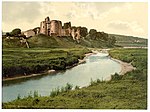Kidwelly Castle
| Kidwelly Castle | |
|---|---|
| Carmarthenshire, Wales | |
 Kidwelly Castle | |
 Shown within Carmarthenshire | |
| Coordinates | 51°44′22″N 4°18′21″W / 51.7394081°N 4.305735°W |
| Site information | |
| Owner | Cadw |
| Open to the public | Yes |
| Condition | Ruined |
| Site history | |
| Battles/wars | Revolt of Owain Glyndŵr |
Listed Building – Grade I | |
Kidwelly Castle (Welsh: Castell Cydweli) is a Norman castle overlooking the River Gwendraeth and the town of Kidwelly, Carmarthenshire, Wales.
Early history
[edit]The castle dates from a decision in the very early years of the 12th century to entrust Roger, bishop of Salisbury, as lord of Kidwelly. The castle and adjoining town were built soon after.[1]
History and description
[edit]The present remains of the castle date from the early 12th century.[2] Created as a defence against the Welsh, the castle fell to the Welsh several times in the twelfth century. The Prince of Wales named Lord Rhys, as he was later known, captured Kidwelly Castle in 1159 and was recognised by King Henry II of England as the ruler of the region.[3] Upon his death, it was passed to the Anglo-Normans. The castle was captured and razed by Llywelyn the Great in 1231.[4] Later in its history, it was unsuccessfully besieged by forces of Owain Glyndŵr in August 1403 with assistance from soldiers from France and Brittany who captured Kidwelly town. The castle was relieved by a Norman army in September 1403.[5]
The plan of the castle consists of a square inner bailey defended by four round towers, which overlook a semi-circular outer curtain wall on the landward side, with the massive gatehouse next to the river. The defensive precautions taken at Kidwelly were not as thorough as those found in the other great Welsh castles of the time, and most of the focus of the builders was in the strength of their walls and towers. The outer curtain possesses a stair built against it, from the level of the ward, a rare feature in English castles of that time.[6] The river prevents this from being a truly concentric plan, however a jutting tower protects the riverside walls, and the final plan is very strong. The castle is relatively well-preserved, and is managed by Cadw.[2]
The surrounding countryside is reputedly haunted by the headless ghost of Gwenllian ferch Gruffydd, wife of the Welsh prince Gruffydd ap Rhys, who was beheaded in 1136.[7]
In film
[edit]Kidwelly was used as a location for the 1975 film Monty Python and the Holy Grail, appearing in the very first scene after the titles.[8]
Gallery
[edit]-
Kidwelly Castle, Wales
-
Plan of Kidwelly Castle
-
Kidwelly Castle, entrance gate
-
View of the walls
-
The castle inner courtyard
-
The castle in the 1890s, with the ruins partly overgrown
See also
[edit]References
[edit]- ^ Kenyon 2007, p. 4.
- ^ a b Cadw. "Kidwelly Castle (Grade I) (11876)". National Historic Assets of Wales. Retrieved 8 May 2022.
- ^ "Kidwelly Castle, Gwenllian – Warrior Princess". cadw.gov.wales. Retrieved 10 January 2023.
- ^ Carpenter, David. Struggle for Mastery.
- ^ "Timeline: 1403". Owain Glyndŵr. Retrieved 21 March 2021.
- ^ Thompson, A. Hamilton (1912). Military Architecture in England During the Middle Ages. pp. 211–307. ISBN 9781536171563.
{{cite book}}: CS1 maint: date and year (link) - ^ Ash, Russell (1973). Folklore, Myths and Legends of Britain. Reader's Digest Association Limited. p. 387. ISBN 9780340165973.
- ^ "Monty Python and the Holy Grail Filming Locations". British Film Locations. Retrieved 23 April 2016.
Sources
[edit]- Kenyon, John R. (2007) [1986]. Kidwelly Castle (4th ed.). Cardiff: Cadw. ISBN 978-1-85760-256-2.
External links
[edit]- Cadw page Archived 12 August 2018 at the Wayback Machine







